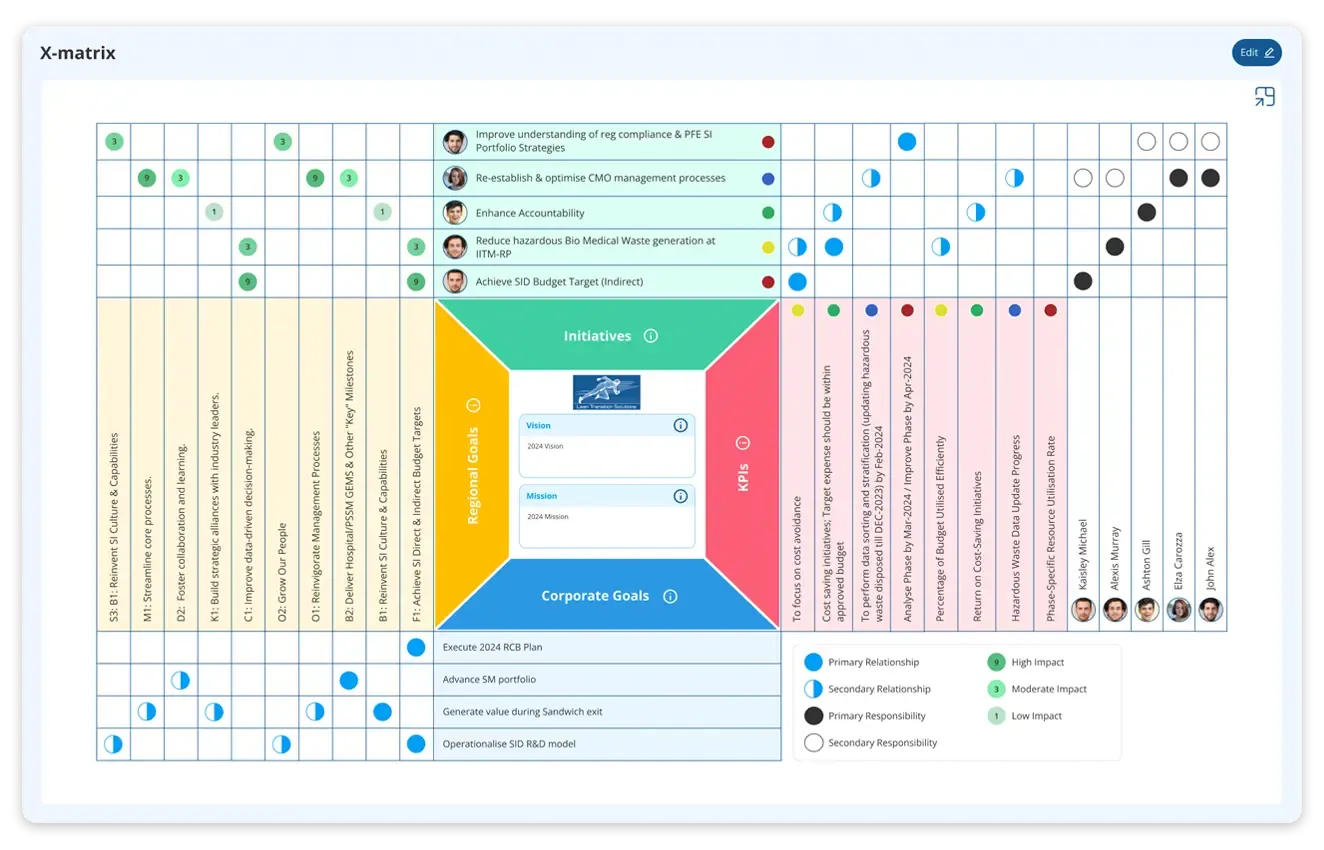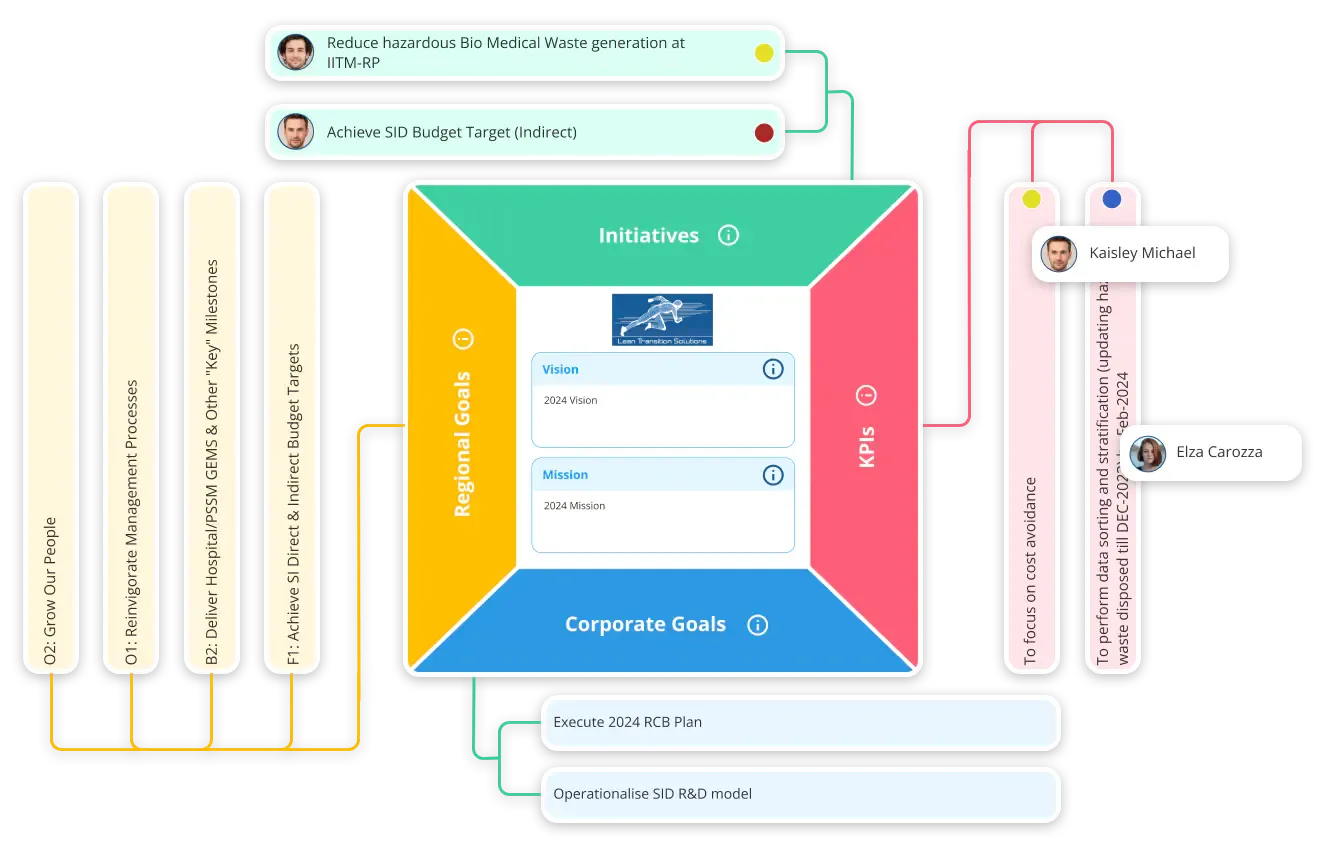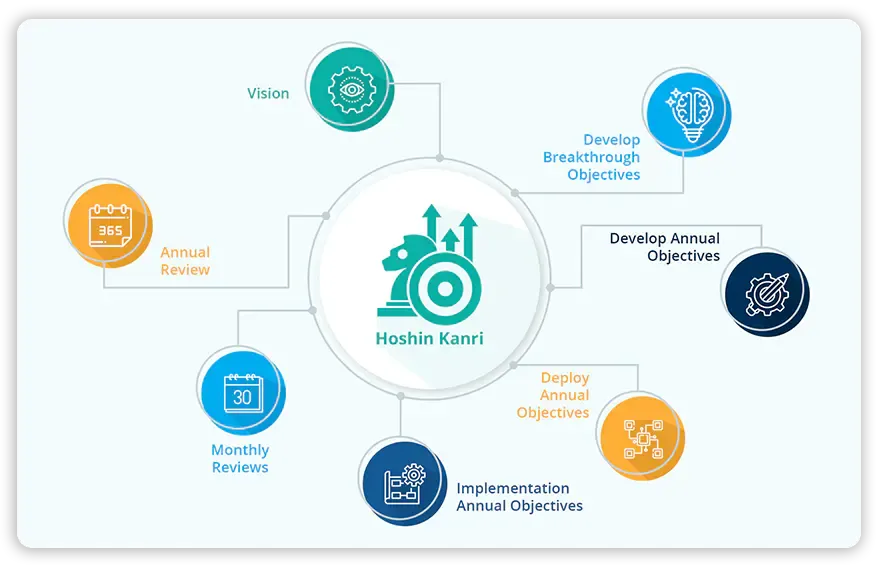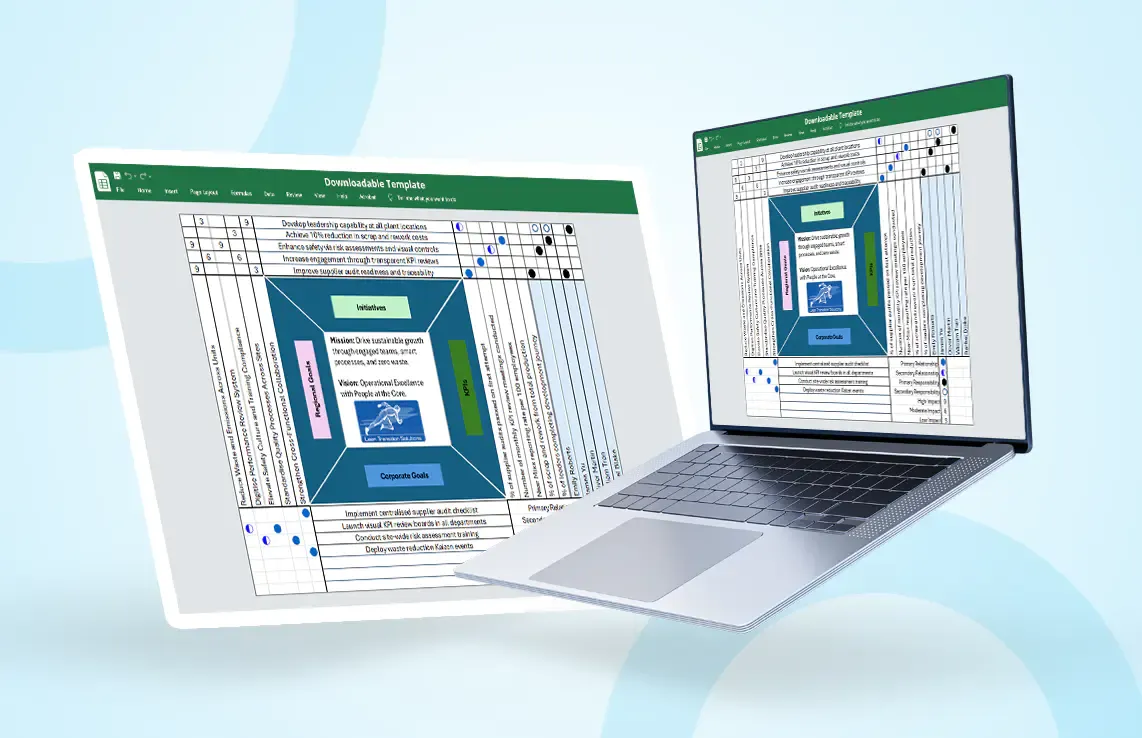
What is the Hoshin Kanri X Matrix?
A Hoshin Kanri X matrix is a powerful visualisation tool that can manage detailed strategic planning. The template contains the goals and strategies of the organisation, how they are to be aligned with the strategic initiatives, and what metrics need to be improved.
A Hoshin matrix will have four key quadrants :
- Long Term Goals(South)- 3-5 year breakthrough objectives
- Annual Objectives(AO) (West)
- Top-level Improvement Priorities (TLIP) (North)
- Targets to Improve(TTI) (East)
At the corners of each matrix, the dependencies of activities are represented. The far right side visualises the people responsible for the plan implementation.
What are the key principles of Hoshin Kanri X matrix , and when to use it?
Hoshin Kanri is a strategic management methodology that originated in Japan. It involves aligning an organisation's strategic goals with its operational activities through a structured planning and implementation process. The principles of Hoshin Kanri provide a framework for effectively managing and achieving these goals.
Key principles of Hoshin Kanri
- Policy Deployment: Top-down cascading of strategic objectives throughout the organisation, ensuring alignment and clarity.
- Catchball: Catchball involves a back-and-forth exchange of ideas, feedback, and negotiation to ensure that objectives are understood, accepted, and realistic.
- PDCA Cycle (Plan-Do-Check-Act cycle): PDCA cycle, also known as the Deming Cycle or the Shewhart Cycle, is a fundamental component of Hoshin Kanri. It promotes continuous improvement by encouraging organisations to plan their strategies, implement them, review the results, and make adjustments as necessary.
- KPI Focus: Emphasis on using KPIs to measure progress and determine strategy effectiveness.
- Cross-Functional Collaboration: Encourages collaboration and teamwork across departments for leveraging diverse perspectives and expertise.
- Continuous Improvement: Foster a learning culture, adapt strategies, and stay aligned with market conditions.
The Hoshin Kanri X matrix is typically employed during the planning phase of Hoshin Kanri. It is a visual tool that helps organisations align their strategic objectives, Key Performance Indicators, and action plans in a single matrix. It clearly visualises the relationship between goals, actions, responsibilities, and performance metrics.
What is a Hoshin Kanri Catchball?

Hoshin Kanri catchball is one of the most efficient management methodologies that allow you to align your company’s goals and objectives with the team’s actions at all hierarchical levels of the organisation.
Hoshin Kanri catchball is the approach for creating and maintaining open feedback loops across all the levels of the organisational hierarchy by establishing a two-way stream of information sharing.
Catchball has a vertical application. Here the top-level management sets the goals for the company and prepares the strategy proposal. They pass it like a ball to the lower levels and wait to receive feedback from them. Iterations occur before the agreement is reached.
The middle management then tosses the ball to the team leaders, and the process continues until the ball reaches the bottom of the pyramid. The main aim behind this process is to provide every team member working towards achieving these goals an opportunity to give input on their part and align the actions in a common direction that everyone shares.
Though the executives throw down the strategy, the process improvements are tossed by the lower management levels and the regular team members. This gives a clear picture for the employees of how they fit into the bigger picture and how they connect to the organisation’s most important objectives.Benefits of applying the catch ball
- Increase the engagement of the team in strategy planning
- Continuous improvement
- A better understanding of the practicality of the plans
- People from multiple areas contribute to the analysis of the plan.
How to start practicing a Catchball?
Follow the universal rules to make catchball a piece of your lean management tool kit.
Understand that catchball should be played by everyone who must contribute to the improvement process. The leader should ensure that everyone has an opportunity to hold the ball. Make sure that everybody understands that they belong to the same team, and even the smallest ideas and suggestions are encouraged.
After receiving the ball, he/she should be given enough time to study the plan and provide feedback before handing the ball to the next person or returning it to the leader. While holding the ball, the person needs to accept the ownership of their ideas and suggestions and ensure that it gets executed by the team.
A person who is not involved or is afraid of holding the responsibility of unsuccessful propositions dodges the ball instead of catching it.
The most important part of the catchball technique is finding the most suitable framework for passing the ball in the organisation. It can be through team meetings or one-to-one discussions, which the team finds comfortable and can bring value.
How does the catchball process in Hoshin Kanri promote organisational alignment and buy-in from different stakeholders?
The catchball process in Hoshin Kanri promotes organisational alignment and buy-in by facilitating the iterative exchange of ideas and feedback between different stakeholders. Through catchball, strategic goals and initiatives are communicated, understood, and accepted at each level of the organisation. This collaborative approach helps to ensure alignment between top-level strategic objectives and operational actions, fostering a shared understanding and commitment to the organisation's goals. By involving stakeholders in the catchball process, Hoshin Kanri helps cascade strategic goals and initiatives throughout the organisation, ensuring everyone is aligned and working towards the same objectives.
Usage of Hoshin Kanri X matrix- What does it bring to your organisation?
- Align company-wide goals with actionable team-level plans
- Translate strategic objectives into measurable KPIs
- Drive cross-functional coordination and accountability
- Manage enterprise transformation with a visual execution roadmap
- Track progress on strategic initiatives in real time
- Bridge the gap between long-term vision and daily activities
- Establish a single source of truth for strategy deployment
- Prioritise initiatives based on business impact and interdependencies
- Ensure every department understands its contribution to strategy
- Facilitate executive reviews with one-page strategic clarity
Read How the Hoshin Kanri X Matrix can shape the Business Strategy for more insights.
Use cases of the Hoshin Kanri X Matrix for CXOs

As a C-suite execution enabler, Hoshin Kanri X Matrix helps CXOs navigating rapid change. The matrix offers clarity, alignment, and control across complex business systems. Here's how senior leaders use it to drive outcomes:
CEO: Aligning vision with execution across the enterprise
Challenge: Ensuring long-term vision isn’t diluted by departmental silos or tactical distractions.
How the X Matrix helps: The CEO uses it to translate 3–5 year strategy into annual goals and initiatives, assigning clear ownership. It becomes a real-time map of execution progress—highlighting who is doing what, why it matters, and where adjustments are needed.
Value delivered: Strategic alignment, visibility, and quicker course correction.
CFO: Linking financial performance with operational strategy
Challenge: Connecting budget allocations to outcomes, and tracking ROI across initiatives.
How the X Matrix helps: Every financial target is backed by initiatives and KPIs. The CFO uses the matrix to prioritise investments that move the dial on EBITDA, cost control, and asset efficiency.
Value delivered: Financial clarity, investment justification, and risk-managed spending.
CIO/CTO: Driving digital transformation with measurable outcomes
Challenge: Delivering enterprise-level transformation while avoiding initiative overload or misalignment.
How the X Matrix helps: The CTO aligns transformation initiatives—like ERP rollouts or AI integration—with broader strategic goals. It reveals interdependencies across departments and enables technology leaders to prioritise based on business impact, not technical novelty.
Value delivered: Strategic IT governance, change control, and tech-to-business translation.
CMO: Aligning marketing outcomes with corporate strategy
Challenge: Ensuring branding, campaigns, and CX initiatives contribute to enterprise growth objectives.
How the X Matrix helps: The CMO uses it to tie top-line targets (like market expansion or product adoption) with marketing KPIs. Every major initiative—from rebranding to digital funnel optimisation—has strategic context and executive oversight.
Value delivered: Marketing accountability, brand alignment, and performance-led planning.
COO: Operationalising strategic priorities on the ground
Challenge: Translating high-level objectives into repeatable, measurable daily actions.
How the X Matrix helps: The COO can ensure that Lean, Six Sigma, or continuous improvement initiatives directly support corporate goals. It becomes a shared visual between leadership and operations for driving margin, throughput, and quality improvements.
Value: Execution discipline, real-time visibility, and operational scalability.
CHRO: Embedding strategy into people and culture
Challenge: Making culture and capability development part of strategy—not a disconnected HR activity.
How the X Matrix helps: The CHRO ties leadership development, DEI goals, or workforce transformation efforts to enterprise strategy. It supports talent planning based on measurable business need.
Practical applications of the Hoshin Kanri X Matrix
Relevance of the Hoshin Kanri Matrix: Why to choose it
A well-thought strategy and a relentless execution can only make your organisation withstand market competition. Aligning the employees with the goals can prove challenging even for small organisations. Here the effective implementation of Hoshin Kanri can help the team to develop a vision, list the breakthrough goals, and create a cascade of complementary goals by ensuring the alignment and providing necessary leverage for successful execution.
Hoshin Kanri otherwise known as Policy Deployment is the methodology that guarantees whether the company’s strategic goals are driving progress and action at every level within the organisation. They also eliminate the waste that comes from inconsistent direction and poor communication.
Hoshin Kanri seeks to get the team to act together simultaneously by aligning the company goals and strategy with the plans and tactics of the middle management and the performance of the employees in the operations. Simply put, Hoshin Kanri bridges the gap between strategy and execution by building alignment and focus.
Read how to break down organisational barriers with Hoshin Kanri.
Step-by-step walkthrough of strategy deployment: How to implement Hoshin Kanri?

Follow the implementation steps to have a better idea of your strategic plans.
Creating a Strategic Plan
The Hoshin Kanri or strategy deployment starts with strategic planning. This is usually an annual plan set by the top management to further the organisation’s long-term goals. A well-crafted plan it should deal with even minor critical issues.
Keep in mind the following while creating the plan.
- Focus on Five Goals at a time: Focusing on a smaller number of goals makes the achievement of the goals create the feeling of progress rather than disbanding the success across a dozen goals.
- Put Effectiveness first: Effectiveness is doing the right things. Efficiency, on the other hand, is doing things right. Strategic goals need to be effective; if the goal does not have the right impact, it is not strategic.
- Evolutionary and Revolutionary goals: Goals can be both evolutionary in that the incremental goals are usually achieved through continuous improvement. They can be revolutionary because they can bring about breakthrough changes with a dramatic scope. Both are essential forms of advancement.
- Get a hierarchical agreement: Though the higher management is responsible for developing strategic planning, discussions with the middle management can be beneficial as the additional perspectives and feedback can help the goals become stronger. Shared responsibility is also created here.
- Set the KPIs carefully: KPIs track the progress towards the goals. Choose your KPIs with care as they have the significant capacity to drive the behaviour.
- Own the goal: Every goal should have an owner or a facilitator who can drive the plan to a successful position.
Developing Tactics
The mid-level managers develop the tactics and plan to accomplish the goals laid down by the top management effectively. Through the catchball, an up and down exchange of ideas occurs, ensuring the team understands the strategic goals well, there is a proper alignment between the strategy and tactics, and the KPIs are relevant and significant. Tactics vary through the process of fulfilling the goals; in that case, a regular review of the progress should be done.
Take Action
The actions in implementing the tactics laid down by the managers occur on the shop floor. Goals and plans are transformed into the results here. The shopfloor forms the real Gemba, and the managers, therefore, make sure that they should closely connect to the activity at this level.
Review and Adjust
As the catchball passes the information from the top management, there is an equal responsibility to share the progress and results in the other direction. The flow of this information closes the loop and controls and adjusts the entire process. Reviewing progress should be done regularly, and this should provide a platform for the adjustment of the tactics and their associated operational details.
Common challenges in Hoshin Kanri execution
- Lack of cross-functional alignment – Teams work in silos without shared priorities.
- Overloading the matrix – Too many goals dilute focus and impact.
- Unclear ownership – No accountability leads to stalled progress.
- Disconnected metrics – KPIs don’t reflect strategic intent.
- Poor follow-up discipline – No cadence for reviews or course corrections.
- Focusing only on top-down planning – Ignoring frontline feedback and bottom-up insights.
- Static planning mindset – Strategy isn’t revisited or adapted as things change.
- Overcomplicating the tool – X Matrix becomes hard to understand or use in practice.
Real-world case of a department translating top-level goals into measurable projects
Let’s say the operations department of a consumer goods manufacturer is using the Hoshin Kanri X Matrix to align with the company’s strategic focus on sustainability, cost efficiency, and market agility.
Long-term objectives (South)
- Reduce carbon footprint by 40% within 5 years
- Cut production costs by 25% while maintaining quality
- Achieve zero-waste manufacturing across all plants
- Reduce time-to-market by 30% for new product launches
Annual objectives (West)
- Implement energy-efficient systems in 3 key plants
- Optimise raw material usage by 10%
- Launch a waste recycling initiative across departments
- Shorten prototyping phase by 20%
What is Hoshin Planning, and what are the six major elements of the Hoshin planning system?
Hoshin Planning is a strategic management process that helps organisations align their goals, plans, and actions for achieving long-term success. The six major elements of the Hoshin planning system are:
- Vision: A clear and inspiring vision of the organisation's future state.
- Breakthrough Objectives: Ambitious and specific goals that will drive significant progress towards the vision.
- Strategies: The overarching approaches and initiatives designed to achieve the breakthrough objectives.
- Action Plans: Detailed plans that outline the specific actions, responsibilities, and timelines required to implement the strategies.
- Deployment: Cascading the strategic objectives throughout the organisation, ensuring alignment and clarity.
- Execution: Implementing and monitoring the plans, reviewing progress, and making adjustments as necessary to achieve the objectives.
How to use the Hoshin Kanri X matrix for strategic planning?
Identify Strategic Goals: Begin by clearly defining your organisation's strategic goals. These goals should align with the overall vision and mission of the organisation.
- Determine Key Performance Indicators (KPIs): Identify the specific metrics and KPIs that will be used to measure progress towards each strategic goal. These should be measurable and aligned with the desired outcomes.
- Create Action Plans: To achieve each strategic goal, it is important to create action plans that outline the specific tasks, initiatives, and projects involved. Ensure that each action plan is aligned with a specific strategic goal and has assigned responsibilities.
What is the Hoshin Kanri X-Matrix Excel Template?

The Hoshin Kanri X-Matrix template is a ready-to-use or custom-made tool—available in Excel or other editable formats—that links strategic objectives to KPIs, priorities, and accountable owners in a single, visual framework. Whether you download it or build your own, completing the template helps you map the critical connections between long-term goals and the actions required to achieve them.
It’s an ideal starting point before transitioning to a digital Hoshin Kanri solution, giving you clarity, alignment, and a structure you can act on immediately.
How can you integrate Hoshin Kanri into other lean tools, such as Kanban, to maximise its effectiveness?
Using Hoshin Kanri, along with other lean tools, such as Kanban, can maximise efficiency by allowing for a holistic approach to strategic planning and operational execution. This fosters a culture of continuous improvement.
- Aligning Kanban with Strategic Objectives: Ensure that the work items and tasks managed through Kanban boards directly contribute to the strategic goals defined in the Hoshin Kanri plan. This alignment ensures that operational activities align with the overall strategic direction.
- Prioritising Work: Use the Hoshin Kanri X matrix to identify and prioritise the most critical initiatives and projects. This prioritisation can be reflected in the Kanban system, guiding the workflow and ensuring that resources are allocated to the most important tasks.
- Visualising Progress: Kanban boards provide a visual representation of work in progress. By integrating this visual management approach with the Hoshin Kanri X matrix, teams can easily see how their tasks and projects contribute to the broader strategic goals. This transparency facilitates better decision-making and promotes accountability.
- Feedback Loops: Implement feedback loops between the Kanban and Hoshin Kanri processes. Regularly review the performance of tasks and projects tracked in Kanban against the defined strategic goals. This feedback helps identify gaps, adjust priorities, and make data-driven improvements to the overall strategic plan.
What are the advantages of Hoshin Kanri X Matrix software or digitalised solution over X Matrix Excel templates?
What are the challenges faced while using the traditional policy deployment matrices?
The common challenges faced while using the traditional policy deployment matrix such as Excel or paper are:
- Visibility of breakthrough objectives and annual targets will be missing.
- Difficulty in visualising the overlapping of business activities between the distinct business areas in the larger organisations.
While Excel templates can still be effective for small-scale implementations, Hoshin Kanri X Matrix software or digitalised solutions offer enhanced efficiency, collaboration, data visualisation, accuracy, tracking, reporting, and integration capabilities, making them a valuable choice for larger organisations or those seeking to optimise their strategic planning processes.
Is Hoshin Kanri a better way for your organisation to achieve True North?
Hoshin Kanri is a method that helps organisations reach their True North by providing a structured and systematic approach. This is achieved through aligning strategic goals, promoting collaboration, emphasising accountability, and encouraging continuous improvement.
Hoshin Kanri example
Let's see the Hoshin Kanri example for a Manufacturing industry and how implementing the Hoshin Kanri X Matrix in their organisation affects their strategic planning and management.
The Manufacturing company specialising in producing industrial machinery aims to improve product quality and competitiveness in the market, thereby increasing customer satisfaction. The management team identifies its strategic objectives, specific initiatives and action plans to achieve this goal.
Creating a Hoshin Kanri X Matrix helps them visualise how the alignment between strategic objectives and operations could be set up. Each strategic objective is included in the row, and the initiatives are in the columns. The intersection of a strategic objective and initiative represents a specific action.
Once the Hoshin Kanri template is set up, the manufacturing company establishes Key Performance Indicators (KPIs) to track the progress of each initiative. Regular reviews and progress monitoring ensure that initiatives are on track and action plans are conducted accordingly.
Being a versatile tool used in various industries, including manufacturing, automotive, healthcare, electronics, energy, and many more, Hoshin Kanri helps organisations prioritise strategic objectives, define actionable initiatives, and monitor progress effectively. By implementing Hoshin Kanri, organisations across various sectors can enhance their strategic planning process and drive continuous improvement.
How do Hoshin Kanri X Matrix templates help organisations to track progress and adjust business plans accordingly to gain a competitive advantage?
Hoshin Kanri X Matrix templates help organisations track progress and adjust business plans by visualising strategic goals, action plans, and Key Performance Indicators (KPIs). The templates allow organisations to monitor and measure their progress against the set goals, enabling timely identification of performance gaps. By regularly reviewing the X Matrix, organisations can make data-driven adjustments to their business plans, reallocating resources and refining strategies to stay on track and gain a competitive edge.
Stay ahead by turning your strategy into daily action
What is the difference between Hoshin Kanri X Matrix and Balanced Scorecard?
Hoshin Kanri X Matrix and Balanced Scorecard are both strategic execution frameworks, but they have some key differences:
Purpose:
- Hoshin Kanri X Matrix focuses on goal deployment and alignment throughout the organisation to drive strategic execution.
- Balanced Scorecard aims to translate the organisation's strategy into specific performance measures and targets to monitor and manage performance.
Structure:
- Hoshin Kanri X Matrix uses a matrix format that visually represents strategic goals, action plans, responsible parties, and performance indicators.
- Balanced Scorecard typically consists of four perspectives - Financial, Customer, Internal Processes, Learning and growth (FCIL) with associated objectives, measures, targets, and initiatives.
Focus:
- Hoshin Kanri X Matrix emphasises the top-down alignment of strategic objectives across the organisation, cascading goals from the strategic level to operational levels.
- Balanced Scorecard provides a balanced view of performance across multiple dimensions (financial, customer, internal processes, learning and growth) and encourages a more holistic approach.
Implementation:
- Hoshin Kanri X Matrix often involves a collaborative process to establish and deploy goals, with regular reviews and adjustments to ensure alignment and progress.
- Balanced Scorecard requires defining and tracking specific metrics, with periodic performance reviews to monitor progress and make strategic adjustments.
It's worth noting that while they have differences, Hoshin Kanri X Matrix and Balanced Scorecard can complement each other and be combined to enhance strategic execution and performance management in organisations.
How can organisations maximise the effectiveness of using the Hoshin Kanri X matrix template for strategic planning?
What makes Hoshin Kanri different from OKRs and OGSM?
Hoshin Kanri, OKRs (Objectives and Key Results), and OGSM (Objectives, Goals, Strategies, and Measures) are all strategic planning and execution frameworks, but they have some key differences:
- Hoshin Kanri emphasises a top-down approach to goal deployment and alignment throughout the organisation. It focuses on cascading strategic goals from the top level to lower levels, ensuring alignment and integration of efforts.
- OKRs are a goal-setting framework that combines ambitious and measurable Objectives with specific Key Results. They are often set at various organisational levels and clearly focus on outcomes and measurable results.
- OGSM is a strategic planning framework that defines the overall Objectives, specific Goals, the Strategies to achieve them, and the Measures to track progress. It provides a comprehensive strategic planning approach, incorporating goal-setting and strategic actions.
While Hoshin Kanri focuses on goal deployment and alignment, OKRs primarily focus on ambitious goal setting with measurable results, and OGSM provides a more comprehensive strategic planning framework. Each framework offers a different approach and can be chosen based on an organisation's specific needs and context.
What are the challenges faced while using the Hoshin Kanri matrix, and how to overcome the challenges in implementing Hoshin Kanri X Matrix?
Having strong leadership support and commitment is the key to overcoming the leadership challenge.
- Conducting training sessions and workshops can help address the challenge of team members not being aligned or understanding the Hoshin Kanri X Matrix.
- Setting realistic and achievable objectives and KPIs can be challenging. Ensure your objectives and KPIs are realistic and aligned with your organisation's strategic goals by regularly reviewing and adjusting them.
- Clear and convincing explanations of the Hoshin Kanri X Matrix's advantages are crucial to addressing employee resistance and lack of commitment.
- A major obstacle to implementing the Hoshin Kanri X Matrix is the shortage of resources and time. To overcome this, it is crucial to prioritise and allocate resources appropriately.







